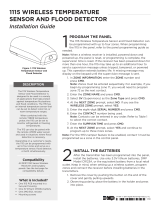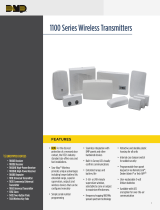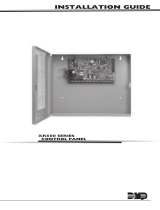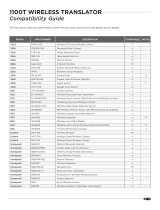Page is loading ...

K9947V2 10/05 Rev. A
ADEMCO 5821
Temperature Sensor & Flood
Detector
INSTALLATION AND SETUP GUIDE
GENERAL INFORMATION
The ADEMCO 5821 Temperature Sensor & Flood Detector is a
wireless transmitter used with Honeywell’s ADEMCO alarm
systems that support 5800 series devices. The 5821 can be
configured to operate as a stand-alone temperature sensor
and/or as either a Remote Temperature Sensor
or
Flood
Detector. The 5821 in combination with the ADEMCO T280R
temperature probe is ideal for monitoring refrigerators and
freezers in restaurants, kitchens and warehouses where food
storage is a concern. The 5821 in combination with the
ADEMCO 470PB probe can be used to sense floods in
basements and other areas where there is a possibility of
flooding. The 5821 will send an alarm, via its RF transmitter, to
the control when the preset temperature limit is exceeded or
when a flood is detected. Temperature monitoring and flood
detection is dependent on the operating mode selected. Refer
to Table 1 for applicable operating modes.
Room temperature is monitored at the device using the 5821’s
internal sensor. Refrigerator or Freezer temperature is
monitored remotely using the ADEMCO T280R temperature
probe. Flood detection is monitored remotely using the
ADEMCO 470PB probe with the supplied resistor. A separate
5821 is required for each external probe being used.
In refrigerator or freezer applications, when the temperature
increases past the high threshold limit and a delay of greater
than 30 minutes passes, an alarm is triggered. This preset
delay offers greater reliability against false alarms, especially
due to open refrigerator or freezer doors.
A 3-volt lithium battery powers the 5821. If the battery voltage
gets too low, the 5821 sends a low battery signal to the control
panel.
INSTALLING/REPLACING THE BATTERY
Important Notes:
• Use 3-volt lithium battery:
Duracell DL 123A or Panasonic/Sanyo/Tekcell/Varta
CR123A.
• Observe polarity.
• When replacing the battery, wait at least 30 seconds after
removing the old battery, before installing the new one.
Install or replace the battery as follows:
1. Remove the transmitter's top cover by inserting the flat
blade of a small screwdriver into the pry-off slot at one end
of the unit (see Figure 1 for location), and slightly twisting
the blade until the cover disengages.
2. Install a 3-volt lithium battery as shown in Figure 1.
TAMPER SUPERVISION
The 5821 tamper supervision feature (Loop 4) causes a trouble
signal to be sent to the control if the unit’s cover is removed
from the base or if an external probe is used and the wire is cut
(open) or the probe is shorted. The tamper switch is also
used to program the unit’s serial number and loop assignments
to the control panel.
SETTING THE OPERATING MODE
Table 1 provides a list of the various operating modes of the
5821 with the respective Loop and DIP Switch settings for
each. Note that Cold Temp Sensing can be used in
combination with any of the other operating modes. To use the
transmitter to monitor two different conditions, you must
program each loop used on the 5821 as its own zone, and you
must set the DIP Switches as shown for the combination
functions in Table 1.
PROGRAMMING THE UNIT
Once you have selected an operating mode and have set the
DIP Switches accordingly, you must enroll the transmitter in
the control panel. When programming the transmitter in the
control panel, note that you must program a separate zone for
each loop you are using on the transmitter. To program:
1. Enter the control’s Zone Programming mode.
2. Enter the zone number to be programmed.
3. Enter the applicable zone type when prompted (zone
types such as 24-Hr. Aux, Waterflow, etc. should be used)
depending on the function of the zone and the control
panel being used (see the control panel’s instructions for
available zone types and definitions).
4. When prompted, enter Input Type 03 (3 on some controls)
– Supervised RF Transmitter.
5. When prompted for the serial number, transmit from the
detector by pressing the tamper switch.
6. When the serial number is displayed, transmit from the
detector again by pressing the tamper switch.
The current loop number (4) will begin to flash.
7. Manually change the loop number to the desired loop
number for the zone (according to the application—see
Table 1).
8. When programming for this zone is complete, program
other zones for the transmitter as necessary (each loop
requires its own zone.
9. Exit Programming mode when programming is complete,
and test the detector. Refer to the Testing section.

2
MOUNTING THE DETECTOR
You can mount the 5821 on a wall or ceiling within the
protection area. The following notes apply:
• The 5821 may be installed in any direction.
• When used in-conjunction with the ADEMCO 470PB flood
sensor probe, use no more than 48 inches of wire from the
5821 to the flood sensor and connect the termination
resistor across the probes terminals.
• When used in-conjunction with ADEMCO T280R
temperature probe, use the shortest wire possible (less
than 96 inches) to improve the signal integrity.
• Although the unit can be mounted directly to a surface, we
recommend that the mounting plate be used for ease of
removal for servicing if necessary. Avoid mounting the
detector near heat generating devices (e.g. ovens, heat
vents, furnaces, boilers) or to a metal cabinet or surface.
Wireless Transmission Path Test
A good RF transmission path must be established from the
proposed mounting location before permanently installing the
detector. To determine that there is good signal reception from
the proposed location, perform the test procedure described in
TESTING THE DETECTOR section.
Once a good RF transmission path is confirmed, mount the
detector as follows, referring to Figure 1.
5821-001-V0
LOCKING
TA B
RELEASE
WINDOW
COVER PRY-OFF SLOT
MOUNTING
PLATE
HOLES (2)
OBSERVE POLARITY
LOCKING
TAB
WIRES
MOUNTING PLATE CASE
COVER
RETAINING
HOOKS
(3)
POST (2)
5821-002-V1
LOOP
TERMINALS
BATTERY
CR123A
COVER
RETAINING
HOOKS (3)
ANNTENNA
DIP SWITCH
+
+
COVER
PRY-OFF
SLOT
WIRE ENTRY
HOLE
TAMPER
SWITCH
IC
CRYSTAL
+
_
21
ON
21
ON
Figure 1
To mount the detector, proceed as follows:
1. Remove the battery.
2. Disengage the attached mounting plate from the case by
inserting the blade of a small screwdriver into the locking
tab release window (see Figure 1) and pressing it against
the locking tab (also shown in Figure 1), while sliding the
mounting plate upward along the case back until free.
3. Install the mounting plate, with its two case- holding posts
pointing up (in this example), in the location selected. Use
the flat-head screws supplied.
4. For surface wiring entry, two thin "breakout" areas are
provided in the case wall (see Figure 1).
5. Attach the case back to the mounting plate by sliding the
keyhole slots in the case back down onto the mounting
plate's case holding posts. The locking tab will click as the
case back locks in place.
External Probe Wiring Connections (If used)
6. With the battery still not inserted, connect the wires to the
unit's sensor terminals (see Figure 1).
7. Install the battery.
IMPORTANT:
This detector should be used for property protection. Reliance
should not be placed on this detector for life safety. When life
safety is involved, smoke detectors MUST also be used. The
flood probe must not be painted.
TESTING THE DETECTOR
The test procedure should be performed to determine a good
RF transmission path and again after installation is completed.
To test,
1. Activate the control panel’s test mode.
2. Activate the detector by removing and replacing the
cover. The system’s keypads should beep and each
zone the 5821 is programmed for will be displayed.
3. Exit the control’s test mode (User Code + OFF).
MAINTAINING PROPER OPERATION
To maintain the detector in proper working condition, it is
important that you observe the following:
Replace the battery when the system indicates that the 5821
reported a low battery condition.
Units should never be relocated without the advice or
assistance of the alarm service company.

3
Table 1: 5821 Operating Mode Choices
✝ When the 5821 is used with either external probe, an open-circuit or a short-circuit of the probe’s wiring results in an alarm on that loop,
and a trouble condition on all other programmed loops.
✝✝ Use a maximum wire length of 48 inches between the 5821 and the 470PB probe.
Operating Mode
Dip
Switch
Setting Loop Faults when… Restores when…
External
Probe ✝
Cold Temp Sensing SW1=OFF
SW2=OFF
1 temperature drops below 45°F
(7°C) for >10 minutes.
temperature rises 48°F (9°C) for
>4 minutes.
No external
probe
Hot Temp Sensing SW1=OFF
SW2=OFF
2 temperature rises above 95°F
(35°C) for >10 minutes.
temperature drops below 92°F
(33°C) for > 4 minutes.
No external
probe
Warm Temp
Sensing
SW1=ON
SW2=OFF 2 temperature rises above 75°F
(24°C) for >10 minutes.
temperature drops below 72°F
(22°C) for > 4 minutes.
No external
probe
Freezer Temp
Monitoring
SW1=OFF
SW2=ON 2 temperature rises above 10°F
(-12°C) for >30 minutes.
temperature drops below 7°F
(-14°C) for > 4 minutes.
Use T280R
external probe
Refrig. Temp
Monitoring
SW1=ON
SW2=ON 2 temperature rises above 42°F
(6°C) for >30 minutes.
temperature drops below 39°F
(4°C) for > 4 minutes.
Use T280R
external probe
Flood Sensing SW1=OFF
SW2=ON 3
external probe tips are in
contact with water for >3
minutes.
probe tips have not been in
contact with water for > 3
minutes.
Use 470PB ext.
probe shunted by
2.2MΩ resistor ✝✝
Cold Temp Sensing
&
SW1=ON
1=Cold
temperature drops below 45°F
(7°C) for >10 minutes.
temperature rises 48°F (9°C) for
>4 minutes.
Warm Temp
Sensing
SW2=OFF 2=Warm temperature rises above 75°F
(24°C) for >10 minutes.
temperature drops below 72°F
(22°C) for > 4 minutes.
No external probe
Cold Temp Sensing
&
SW1=OFF 1=Cold temperature drops below 45°F
(7°C) for >10 minutes.
temperature rises 48°F (9°C) for
>4 minutes.
Hot Temp Sensing SW2=OFF 2=Hot temperature rises above 95°F
(35°C) for >10 minutes.
temperature drops below 92°F
(33°C) for > 4 minutes.
No external probe
Cold Temp Sensing
&
SW1=ON
1=Cold temperature drops below 45°F
(7°C) for >10 minutes.
temperature rises 48°F (9°C) for
>4 minutes.
Refrig. Temp
Monitoring
SW2=ON 2=Refrig temperature rises above 42°F
(6°C) for >30 minutes.
temperature drops below 39°F
(4°C) for > 4 minutes.
Use T280R
external probe
Cold Temp Sensing
&
SW1=OFF 1=Cold
temperature drops below 45°F
(7°C) for >10 minutes.
temperature rises 48°F (9°C) for
>4 minutes.
Freezer Temp
Monitoring
SW2=ON 2=Freezer temperature rises above 10°F
(-12°C) for >30 minutes.
temperature drops below 7°F
(-14°C) for > 4 minutes.
Use T280R
external probe
Cold Temp Sensing
&
SW1=OFF 1=Cold
temperature drops below 45°F
(7°C) for >10 minutes.
temperature rises 48°F (9°C) for
>4 minutes.
Flood Sensing SW2=ON 3=Flood external probe tips are in
contact with water for >3
minutes.
probe tips have not been in
contact with water for > 3
minutes.
Use 470PB
ext. probe shunted
by 2.2MΩ resistor
✝✝

ÊK9947V2}Š
K9947V2 10/05 Rev. A
SPECIFICATIONS
Power: 3V lithium battery
(Duracell DL123A, Panasonic CR123A, Sanyo CR123A,
Tekcell CR123A, Varta CR123A)
CAUTION: Risk of fire, explosion, and burns. Do not
recharge, disassemble, heat above 212°F
(100°C) or incinerate. Dispose of used batteries
promptly. Keep away from children.
Operating Temperature: 14°F (-10°C) to 104°F
(+40°C)
Operating Voltage: 3.2VDC
Dimensions: 3.1” length, 1.6”wide, 1.0”
depth
Sensor Parameters:
Cold Temperature
(Freeze) Detector 45°F (7°C)
Warm Temperature
Detector 75°F (24°C)
Hot Temperature
Detector 95°F (35°C)
Refrigerator Failure
Detector 42°F (6°C)
Freezer Failure
Detector 10°F (-12°C)
Hysteresis ✝✝✝ 3°F (-16°C)
Flood Sensor ¼ inch of water covering
the probe
Response Time
Tolerance ✝✝✝✝ +50%, -20%
Temperature Measurement
Accuracy (internal temp. sensor
or external temp. probe) ±3°F (-16°C)
✝✝✝ Hysteresis is the temperature difference between “fault” and
“restore” points.
✝✝✝✝ The Response Time Tolerance is the time duration necessary
for the device to respond to a “fault” or “restore” condition. This
time does not take into account the time necessary for the probe
and circuitry to equalize to the ambient temperature. This
feature prevents false alarms due to open doors and other
transitory conditions.
TO THE INSTALLER
Regular maintenance and inspection (at least annually) by the installer
and frequent testing by the user are vital to continuous satisfactory
operation of any alarm system.
The installer should assume the responsibility of developing and
offering a regular maintenance program to the user as well as
acquainting the user with the proper operation and limitations of the
alarm system and its components parts. Recommendations must be
included for a specific program of frequent testing (at least weekly) to
ensure the system’s proper operation at all times.
FCC ID: CFS8DL5821-1
This device complies with Part 15 of FCC rules. Operation is subject
to the following two conditions: (1) This device may not cause harmful
interference, and (2) this device must accept any interference received,
including interference that may cause undesired operation.
IC: 573F-58211
REFER TO THE INSTALLATION AND SETUP GUIDE FOR THE
CONTROL PANEL WITH WHICH THIS DEVICE IS USED FOR
WARRANTY INFORMATION AND LIMITATIONS OF THE ENTIRE
ALARM SYSTEM.
165 Eileen Way, Syosset, New York 11791
Copyright © 2004 Honeywell International Inc.
www.honeywell.com/security
/





